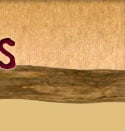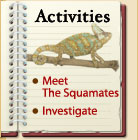 |
Create Your Own Exhibit
What are some of your own personal collections? Maybe you collect
dolls, baseball cards, bugs, letters, trophies, or even photos
from magazines. Think of these items as a collection and curate
your own exhibit. Before you begin, think of the different connections
between these items and the story you want to tell. Choose the
things you want to include and arrange them into an exhibit. How
can you organize the items to best tell your story? Chronologically?
By sport or theme? Finally, create an illustrated pamphlet that
describes and attracts people to your exhibit.
Find the Hidden Squamate
Many snakes and lizards use camouflage, or coloring and patterns,
that help them blend in with their natural environment. This helps
them hide from both predators and prey. Whether they’re
tan like rocks, splotchy and brown like tree bark, or bright green
like leaves, these squamates can almost disappear into their surroundings.
Research a squamate and its habitat, then create a mural showing
the squamate hidden in its habitat.
Squamate Charades
In tonight’s performance, you'll be playing a chameleon!
Explore the snakes and lizards on this site with friends or family
members, then challenge them to a game of squamate charades. Choose
a squamate and think about the way it eats, moves, and defends
itself. Try acting out a chameleon catching prey with its tongue,
a gecko climbing the wall, or a boa squeezing its prey. Can your
friends and family figure out which squamate you are?
Slithering Squamates
Can you slither like a snake? Learn more about the different ways that snakes and other limbless squamates move — like serpentine movement (or lateral undulation), sidewinding, rectilinear motion (in a straight line), and concertina movement (bunching up then extending the body forward). Then try it out for yourself. Get down on your belly and see if you can mimic these amazing movers.
SOS: Save Our Squamates
Worldwide, there are more than 250 species of snakes and lizards
that are threatened, endangered, or of special concern. Choose
one from a Web site like this one: www.iucnredlist.org
or from other research materials, and create a poster about the
animal that explains where it lives, why it’s threatened,
and what can be done to help.
Go on a Herp Hunt
Imagine you’re a herpetologist, a scientist who studies
squamates and other related animal groups. Your challenge is to
observe examples of these animals in their habitat. First, find
a local field guide and discover what species of squamates live
in your area. Then explore a local park, lake, or trail and see
which specimens you can find. Take a notebook with you to sketch
pictures and write down interesting facts about the animals you
observe. Use your field guide and see if you can identify the
different species. Be sure to obey local and federal laws.
|
 |







